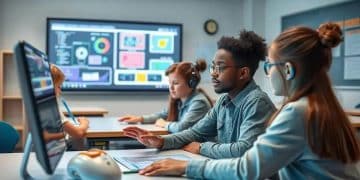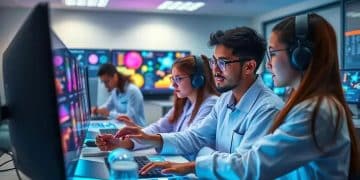Gamified learning platforms trends shaping education
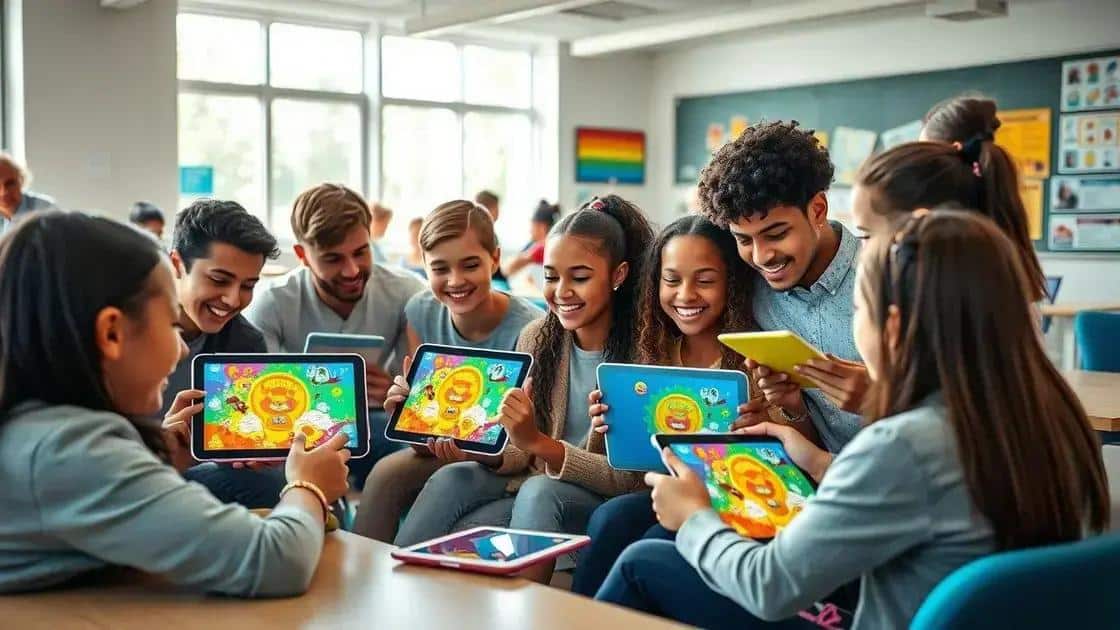
Gamified learning platforms enhance student engagement and motivation through game mechanics, leveraging technologies like AI and VR while facing challenges such as accessibility and ensuring educational value.
Gamified learning platforms trends are changing how we approach education today. Have you ever wondered how game elements could make learning more engaging? Let’s dive into this fascinating topic and see what’s evolving.
Emerging technologies in gamified learning
Emerging technologies in gamified learning are revolutionizing how students engage with educational content. These innovative approaches harness technology to make learning more enjoyable and interactive.
Important Technologies Driving Gamified Learning
Several key technologies are reshaping the landscape of gamified learning. They create environments where students can learn through play and collaboration.
- Artificial Intelligence: AI tailors learning experiences to individual students, ensuring that content is relevant and challenging.
- Virtual Reality: VR immerses students in engaging scenarios, making complex subjects easier to understand.
- Augmented Reality: AR overlays digital information onto the real world, enhancing interactive learning experiences.
- Mobile Apps: These apps provide gamified learning on-the-go, allowing students to learn anytime and anywhere.
Combining these technologies with traditional teaching methods produces a rich learning atmosphere. For instance, artificial intelligence plays a significant role by analyzing students’ strengths and weaknesses. This ensures that lessons are personalized and can adapt to each learner’s pace. Meanwhile, the use of virtual reality empowers students to dive into history or science, experiencing lessons firsthand rather than just reading about them.
The integration of augmented reality further enhances the learning experience by bringing static materials to life. Imagine studying anatomy through AR—where students can visualize complex systems in 3D! This kind of engagement boosts motivation and knowledge retention.
Additionally, mobile apps make gamified learning accessible. Students can earn rewards for completing tasks, fostering a sense of achievement and encouraging them to keep learning. By merging education with play, these apps turn everyday learning into an adventure.
Benefits of gamified learning for students
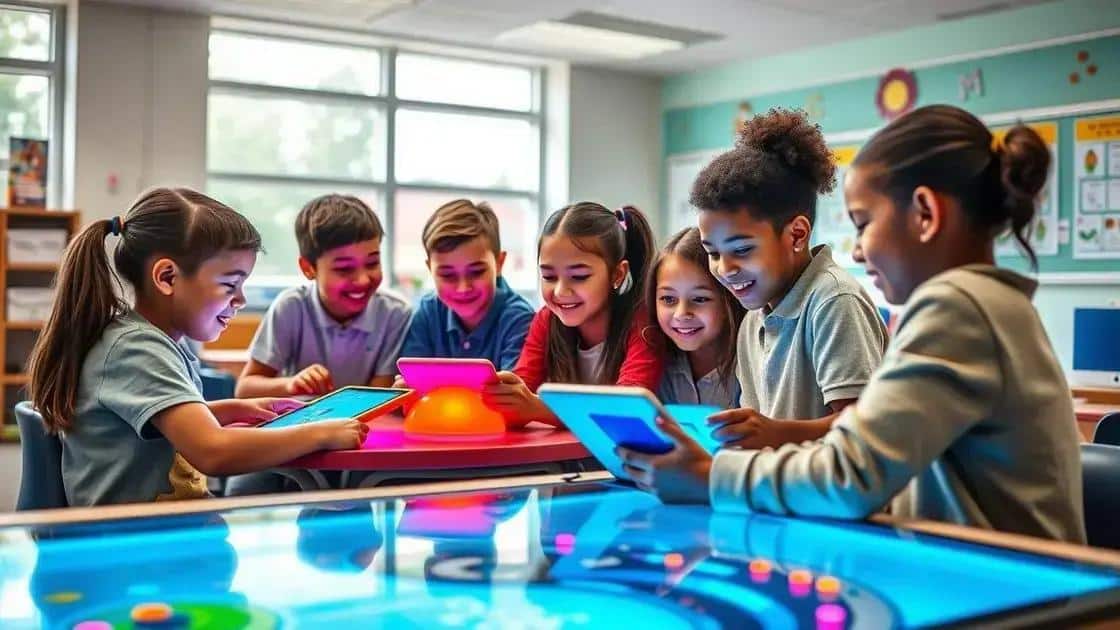
The benefits of gamified learning for students are profound and far-reaching. By integrating game elements into education, students often find themselves more engaged and motivated.
Enhanced Engagement
One significant advantage is the increased engagement that gamified learning provides. When students participate in interactive activities, they are less likely to feel bored or disconnected. This method transforms lessons into rewarding experiences, making students eager to learn more.
- Motivation: Students are more motivated to complete tasks when they can earn points or rewards.
- Active Participation: Gamified experiences encourage students to actively participate rather than passively absorb information.
- Peer Collaboration: Many gamified platforms support teamwork, allowing students to collaborate and learn from one another.
Another important aspect of gamified learning is how it fosters critical thinking and problem-solving skills. Students often face challenges or quests that require them to think creatively and apply what they have learned. This approach helps them develop important life skills beyond just the curriculum.
Personalization is also a key benefit. With gamified learning, platforms can tailor experiences to suit individual students’ needs, allowing them to progress at their own pace. This adaptability ensures that students do not feel left behind or overwhelmed.
Furthermore, gamified learning practices often lead to improved retention of knowledge. When students are having fun and playing games, they tend to remember information better. This interactive nature of learning encourages them to explore concepts in a way that sticks. It’s not just about memorizing facts; it’s about understanding and applying knowledge in real-world contexts.
Challenges faced by gamified learning platforms
The challenges faced by gamified learning platforms can impact their effectiveness in enhancing student learning. As these platforms grow, several obstacles must be addressed to ensure successful implementation.
Technological Limitations
One significant challenge is technological limitations. Not all students have access to the latest devices or stable internet connections. This digital divide can leave some learners behind, making it difficult for platforms to reach their full potential.
- Device Compatibility: Many platforms require specific hardware or software that not every student can access.
- Internet Connectivity: Students in remote areas may face issues with reliable internet access, hindering their ability to participate.
- Technical Skills: Students may struggle with using new technologies, which can create barriers to learning.
Another challenge is ensuring that the content remains educationally relevant while being engaging. There’s a fine line between entertainment and education. Without careful design, gamified elements may distract students from key learning objectives. Balancing fun with educational rigor is essential for success.
Additionally, there is often a lack of adequate training for teachers. Educators may not be fully equipped to implement gamified learning tools effectively. They need proper training to create immersive experiences that foster learning rather than simply introducing games into the classroom.
Assessment and Feedback
Assessment can also be a significant hurdle. Traditional testing methods may not adequately evaluate a student’s understanding in a gamified environment. Instead, educators must develop new ways to assess learning outcomes effectively. This might include tracking progress through gaming metrics or alternative forms of evaluation.
Last but not least, sustaining student interest over time can be challenging. While initial engagement levels may be high, students can become fatigued or lose interest if the gamified experiences are repetitive or lack variety. It’s crucial for these platforms to continuously evolve and offer new content to keep students engaged.
Future trends in gamified learning platforms
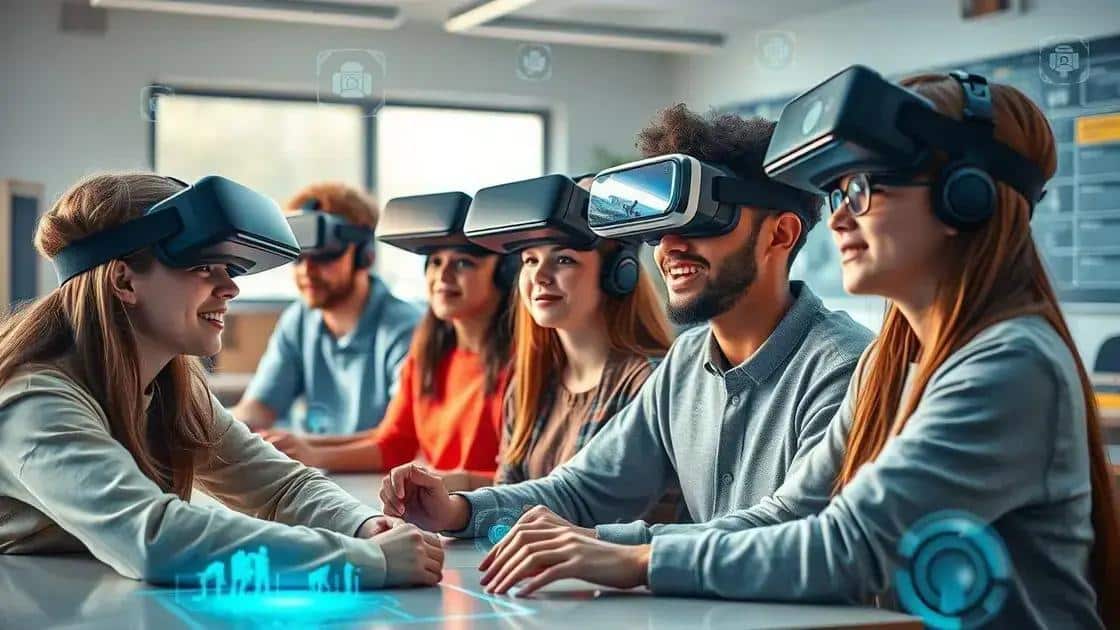
The future trends in gamified learning platforms promise to reshape education in exciting ways. As technology evolves, these platforms will likely become even more effective and influential.
Increased Personalization
One significant trend is the move towards greater personalization. Future platforms will use advanced algorithms and artificial intelligence to tailor learning experiences by analyzing each student’s progress and preferences. This will allow for customized lessons that cater to individual needs.
- Adaptive Learning: This approach will enable students to learn at their own pace, challenging them just enough to keep them engaged.
- AI Tutoring: Virtual tutors will provide on-demand assistance, answering questions and guiding students through challenging concepts.
- User Feedback: Continuous feedback can enhance learning pathways, enabling students to stay informed about their progress.
Another trend involves integrating virtual and augmented reality into gamified learning. These technologies will create immersive environments where students can interact with lessons on a deeper level. Imagine exploring ancient civilizations or conducting science experiments in a virtual lab!
Collaborative learning experiences are also anticipated to rise. Gamified platforms will foster teamwork among students, encouraging them to solve problems together. This can lead to the development of vital social skills while enhancing learning outcomes.
Gamification Beyond the Classroom
The gamification experience may extend beyond traditional classrooms, incorporating real-world applications. For example, platforms can use game mechanics in everyday life scenarios to promote lifelong learning. Students may earn rewards for completing tasks or engaging in community service, turning learning into an ongoing adventure.
Furthermore, the use of analytics will increase. Data collection on student performance and engagement will help educators refine their approaches, offering insights into what works best. This data-driven approach assists in creating better educational experiences tailored to students’ needs.
Lastly, mobile accessibility will continue to expand. As more students rely on smartphones and tablets, gamified learning platforms will ensure that their content is optimized for these devices. This allows learning to be flexible and accessible anywhere, anytime.
FAQ – Frequently Asked Questions about Gamified Learning Platforms
What are gamified learning platforms?
Gamified learning platforms use game-like elements to make education more engaging and interactive for students.
How do gamified learning platforms enhance student motivation?
These platforms increase motivation by incorporating rewards, challenges, and competition, encouraging students to participate actively in their learning.
What technologies are commonly used in gamified learning?
Common technologies include artificial intelligence, virtual reality, and mobile applications to create immersive and personalized learning experiences.
What challenges do educators face when using gamified learning platforms?
Challenges include limited access to technology, balancing fun with educational content, and ensuring all students stay engaged and supported.


